- 2002–03 South Pacific cyclone season
-
2002–03 South Pacific cyclone season 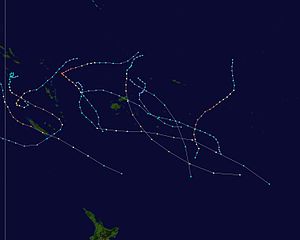
Season summary mapFirst storm formed: July 3, 2002 (Record earliest) Last storm dissipated: June 9, 2003 Strongest storm: Zoe – 890 hPa (mbar), 240 km/h (150 mph) (10-minute sustained) Total disturbances: 18 Total depressions: 15 Tropical cyclones: 10 Severe tropical cyclones: 7 Total fatalities: 16 direct, 20 indirect, 14 missing Total damage: $102.1 million (2003 USD) South Pacific cyclone seasons
2000–01, 2001–02, 2002–03, 2003–04, 2004–05Related articles: The 2002–03 South Pacific cyclone season was an event in the annual cycle of tropical cyclone formation. It began on November 1, 2002 and ended on April 30, 2003. These dates conventionally delimit the period of each year when most tropical cyclones form in the southern Pacific Ocean east of 160°E. Additionally, the regional tropical cyclone operational plan defines a tropical cyclone year separately from a tropical cyclone season, and the "tropical cyclone year" runs from July 1, 2002 to June 30, 2003.[1]
Tropical cyclones between 160°E and 120°W and north of 25°S are monitored by the Fiji Meteorological Service in Nadi. Those that move south of 25°S are monitored by the Tropical Cyclone Warning Centre in Wellington, New Zealand.[1]
Storms

Tropical Depression 17F
Tropical depression (Australian scale) 
Duration July 3 – July 4 Intensity Winds unknown, 995 mbar (hPa) Late on July 3, RSMC Nadi reported that Tropical Depression 17F had formed in area of moderate vertical windshear about 800 kilometres (500 mi) to the northwest of Honiara in the Solomon Islands.[2] The depression had picked up convection during the previous 24 hours and organized with an upper anticyclonic circulation lying to the west of the depression.[2] During the following 24 hours the system lost some of its organization as deep convection had decreased with RSMC Nadi issuing its final advisory early on July 5 as it approached the edge of its area of responsibility.[3][4]
Despite being the first tropical depression of the 2002-03 tropical cyclone year, it was numbered using the last number from the previous tropical cyclone year. The reasons for this are not known.[5]
Tropical Cyclone Yolande
Category 1 tropical cyclone (Australian scale) Tropical storm (SSHS) 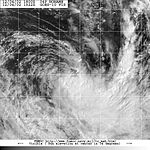

Duration November 29 – December 6 Intensity 65 km/h (40 mph) (10-min), 995 mbar (hPa) Formed on November 29, dissipated on December 6.[6]
Severe Tropical Cyclone Zoe
Category 5 severe tropical cyclone (Australian scale) Category 5 tropical cyclone (SSHS) 

Duration December 25 – January 1 Intensity 240 km/h (150 mph) (10-min), 890 mbar (hPa) Main article: Severe Tropical Cyclone ZoeA depression formed at the end of December. It quickly strengthened into one of the most intense tropical cyclones ever recorded with 10-minute average sustained winds of 130 knots. It eventually went extratropical.[6]
Zoe caused catastrophic damage on several small islands in the south Pacific. There were no direct fatalities. Crops were heavily disrupted and took several years to recover. The name Zoe was later retired.
Severe Tropical Cyclone Ami
Category 3 severe tropical cyclone (Australian scale) Category 3 tropical cyclone (SSHS) 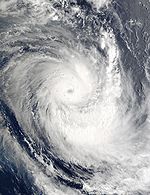

Duration January 12 – January 15 Intensity 150 km/h (90 mph) (10-min), 950 mbar (hPa) By January 10, 2003, a low pressure area formed east of Tuvalu within a broad monsoon trough. Strong wind shear prevented the low from immediately intensifying, although conditions quickly became more conducive to further development.[7] On January 11, the Joint Typhoon Warning Center (JTWC) remarked that the potential existed for the genesis of a significant tropical cyclone in light of ongoing convective organization. Shortly thereafter, they declared the system Tropical Depression 10P,[8] which was also classified Tropical Depression 05F by Regional Specialized Meteorological Centre in Nadi, Fiji (Fiji Meteorological Service). Thunderstorm activity began to significantly increase around the center of circulation, signaling steady strengthening. Tracking southwest, the storm was named Tropical Cyclone Ami at approximately 0000 UTC on January 12 under favorable upper-level diffluence facilitated by the nearby ridge of high pressure.[9][10]
Influenced by an upper-level trough, Ami slowed in forward movement and turned on a more southerly course. With minimal wind shear and a good outflow pattern, Ami achieved severe tropical cyclone intensity at 0600 UTC on January 13.[7] A poorly defined eye feature became visible on satellite imagery, at which point the storm was situated around 160 mi (260 km) north-northeast of Labasa. The cyclone made landfall on Vanua Levu with a minimum barometric pressure of 960 millibars before subsequently crossing the western tip of Taveuni. Broadly turning toward the southeast, Ami traversed the Lau Group.[9] While located about 60 miles south of Lakeba – at 0600 UTC on January 14 – the storm reached its peak intensity with 10-minute maximum sustained winds of 90 mph (140 km/h) and a pressure of 950 mb.[7][11] At the same time, the JTWC assessed the storm with 1-minute winds of 125 mph (201 km/h).[8]
Accelerating toward the southeast with forward speed reaching 40 mph (64 km/h), Ami began to gradually weaken due to resuming wind shear and increasingly cool waters. The cyclone interacted with a frontal boundary, and in doing so it transitioned to an extratropical cyclone. Ami lost all tropical characteristics by 1200 on January 15, although its remnants continued eastward to a point well south of Rarotonga. By late in its life, the storm had exited the area of purview of the Fiji Meteorological Service and the Regional Specialized Meteorology Center in Wellington, New Zealand became responsible for tracking the storm.[7][9]
The storm wrought widespread damage in Fiji, killing 17 people and leaving more than F$100 million (US$53.5 million) in losses.[12]
Severe Tropical Cyclone Beni
Category 5 severe tropical cyclone (Australian scale) Category 4 tropical cyclone (SSHS) 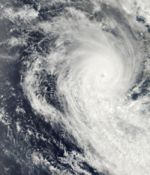

Duration January 25 – January 31 Intensity 205 km/h (125 mph) (10-min), 920 mbar (hPa) Cyclone Beni formed over the Solomon Islands in late January 2003, damaging houses in the archipelago before moving in a south-easterly direction along a course between Vanuatu and New Caledonia. After passing New Caledonia, the cyclone was downgraded into a low-pressure system and moved westwards towards the Australian mainland. Beni reformed off Mackay, Queensland on February 5, crossing the coast as a weak Category 1 system south of that city the following day. The cyclone dumped heavy rain in Central Queensland, resulting in flash flooding which claimed the life of one person and resulted in a A$10 million disaster bill.[13]
Tropical Cyclone Cilla
Category 1 tropical cyclone (Australian scale) Tropical storm (SSHS) 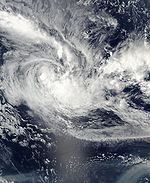

Duration January 27 – January 29 Intensity 75 km/h (45 mph) (10-min), 995 mbar (hPa) Formed on January 25, dissipated on January 30.[13]
Tropical Cyclone Cilla was the ninth wettest tropical cyclone to affect American Samoa.[14] Damage in Tonga was mostly confined to vegetation and fruit bearing trees. The strongest sustained winds of 28 knots (52 km/h; 32 mph) and strongest gusts 58 knots (107 km/h; 67 mph) were recorded in the Ha'apai island group.[15] Power was lost on Lifuka, the main island in the Ha'apai group for about three hours during the night of January 27 and Cyclone Cilla moved over central parts of Tonga.[15] Communications were also affected but restored on January 28.[15]
Severe Tropical Cyclone Dovi
Category 5 severe tropical cyclone (Australian scale) Category 4 tropical cyclone (SSHS) 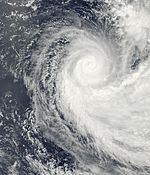

Duration February 5 – February 11 Intensity 205 km/h (125 mph) (10-min), 920 mbar (hPa) Formed on February 5, dissipated on February 12.[16]
Severe Tropical Cyclone Erica
Category 5 severe tropical cyclone (Australian scale) Category 4 tropical cyclone (SSHS) 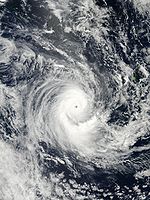

Duration March 4 – March 15 Intensity 215 km/h (130 mph) (10-min), 915 mbar (hPa) Formed on March 4, became extratropical on March 15, 2003. Erica formed near Australia, later hitting New Caledonia.[17]
Severe Tropical Cyclone Eseta
Category 4 severe tropical cyclone (Australian scale) Category 3 tropical cyclone (SSHS) 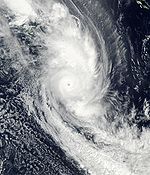

Duration March 10 – March 14 Intensity 185 km/h (115 mph) (10-min), 930 mbar (hPa) A tropical depression formed on March 7, 2003 near Vanuatu. On March 9 the storm was named Eseta, the seventh named storm of the 2002/03 South Pacific cyclone season. Moving south-southeast and then nearly due east, Eseta bypassed the Fiji islands and strengthened into a Category 3 cyclone before becoming extratropical near Rarotonga.[17]
The storm caused flash flooding and moderate damage to banana crops in Tonga. There were no deaths.
Tropical Cyclone Fili
Category 2 tropical cyclone (Australian scale) Tropical storm (SSHS) 

Duration April 13 – April 15 Intensity 95 km/h (60 mph) (10-min), 987 mbar (hPa) Formed on April 13, dissipated on April 15.[18]
Severe Tropical Cyclone Gina
Category 3 severe tropical cyclone (Australian scale) Category 2 tropical cyclone (SSHS) 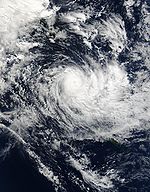

Duration June 5 – June 9 Intensity 150 km/h (90 mph) (10-min), 950 mbar (hPa) Formed on June 4, dissipated on June 9.[19]
Cyclone Gina struck the island of Tikopia that had sustained catastrophic damage from Cyclone Zoe less than two months prior. The storm brought torrential rains and high winds that triggered landslides. Dozens of homes were damaged and many of the newly planted gardens in the recovery phase of Cyclone Zoe were destroyed. The impacts of Gina reportedly set back the recovery efforts for Zoe by nearly six months.[20] A total of 112 newly-built houses and 128 newly-built kitchens were severely damaged and another 37 homes sustained minor damage. The newly planted winter crop was lost due to sea spray and 143 bags of rice, given as relief supplies from Cyclone Zoe, were lost.[21] Following the storm, additional relief supplies and food were rushed to residents to ensure their safety.[22] The new relief materials consisted of local foods, sago and mesh wiring, worth $14,400.[21]
A ship carrying five people became stranded in the Coral Sea during the storm when their engine failed on June 7. A mayday signal was put out by the captain but rough seas produced by the storm hampered rescue efforts.[23] Later that day, two more people were discovered to have gone missing during the storm once the first five people were safely rescued.[24]
Storm names
Non-frontal low pressure systems of synoptic scale developing over warm waters are named whenever surface observations and/or Dvorak intensity analysis indicates the presence of gale force or stronger winds near the centre. Unlike the Atlantic standard, an unnamed tropical system may have gales in one or more quadrants but not near the centre.[1]
Tropical cyclones forming between 160°E and 120°W are assigned names by the Fiji Meteorological Service. If a tropical cyclone forms in Wellington's area of responsibility, south of 25°S, the cyclone will still be given a name from the Fiji list.[25] No tropical cyclone has ever been observed in the South Pacific Ocean east of 120°W,[26] and if one forms in the future, it is unclear how it will be handled.
Names used in the South Pacific are used sequentially, unlike lists used in the Atlantic Ocean and east Pacific Ocean by the National Hurricane Centre. Only the names used during this cyclone season are listed below. The complete list of names are found in the World Meteorological Organization's official list.
- Yolande
- Zoe
- Ami
- Beni
- Cilla
- Dovi
- Eseta
- Fili
- Gina
Note also that Cyclone Erica entered the region from the Coral Sea in the Australian basin.
Retirements
The names Zoe, Ami, Beni, Cilla were retired from RSMC Nadis list of names whilst Erica was removed from TCWC Brisbanes list of names.
See also
- List of Southern Hemisphere tropical cyclone seasons
- Atlantic hurricane seasons: 2002, 2003
- Pacific hurricane seasons: 2002, 2003
- Pacific typhoon seasons: 2002, 2003
- North Indian Ocean cyclone seasons: 2002, 2003
References
- ^ a b c http://www.wmo.ch/web/www/TCP/OperationPlans/TCP24-English2004.pdf[dead link]
- ^ a b "Tropical Cyclone Advisories issued on 2002-07-03". Fiji Meteorological Service. MT Archive. 2002-07-03. http://mtarchive.geol.iastate.edu/2002/07/03/text/Severe.03. Retrieved 2009-09-02.
- ^ "Tropical Cyclone Advisories issued on 2002-07-04". Fiji Meteorological Service. MT Archive. 2002-07-04. http://mtarchive.geol.iastate.edu/2002/07/04/text/Severe.04. Retrieved 2009-09-02.
- ^ "Tropical Cyclone Advisories issued on 2002-07-05". Fiji Meteorological Service. MT Archive. 2002-07-05. http://mtarchive.geol.iastate.edu/2002/07/05/text/Severe.05. Retrieved 2009-09-02.
- ^ Gary Padgett (2002). "Monthly Global Tropical Cyclone Summuary: July 2002". Australian Severe Weather. http://australiasevereweather.com/cyclones/2003/summ0207.htm. Retrieved 2009-09-02.
- ^ a b Gary Padgett (January 2003). "Monthly Global Tropical Cyclone Summary, December 2002". http://www.australiansevereweather.com/cyclones/2003/summ0212.htm. Retrieved 2007-12-02.
- ^ a b c d J.B. Courtney (June 2, 2005). "The South Pacific and southeast Indian Ocean tropical cyclone season 2002-03". Australian Meteorology Magazine (Queensland Regional Office, Bureau of Meteorology, Australia) 54: 137–150. http://reg.bom.gov.au/amm/docs/2005/courtney.pdf. Retrieved February 15, 2011.
- ^ a b Joint Typhoon Warning Center (2003). "Tropical Cyclone 10P Best Track". United States Navy. http://www.usno.navy.mil/NOOC/nmfc-ph/RSS/jtwc/best_tracks/2003/2003s-bsh/bsh102003.txt. Retrieved February 15, 2011.
- ^ a b c Gary Padgett. "Monthly Global Tropical Cyclone Summary: January, 2003". Typhoon2000. http://www.typhoon2000.ph/archives.htm. Retrieved February 15, 2011.
- ^ Joint Typhoon Warning Center. "Tropical Cyclone AMI: JTWC Advisories". Australian Sever Weather. http://www.australiasevereweather.com/tropical_cyclones/2002_2003/warnings/tropical_cyclone_ami_jtwc_advisories.htm. Retrieved February 15, 2011.
- ^ "TCWC Wellington Best Track Data 1967–2006". Fiji Meteorological Service, Meteorological Service of New Zealand Limited, Bureau of Meteorology. National Oceanic and Atmospheric Administration. February 15, 2011. ftp://eclipse.ncdc.noaa.gov/pub/ibtracs/original-bt-data-files/wellington/TC_BT_1967_2006.xls. Retrieved December 5, 2010.
- ^ http://wwwsoc.nii.ac.jp/jsnds/contents/jnds/26_1_3.pdf[dead link]
- ^ a b Gary Padgett (2003). "Monthly Global Tropical Cyclone Summary, January 2003". Archived from the original on 2011-01-23. http://www.australiansevereweather.com/cyclones/2003/summ0301.htm. Retrieved 2007-12-02.
- ^ David Roth (2009). Tropical Cyclone Rainfall Maxima. Hydrometeorological Prediction Center. Retrieved on 2007-03-15.
- ^ a b c "Tropical Cyclone Summary 2002–2003 Season". RSMC Nadi. http://www.met.gov.fj/documents/TC_Seasonal_Summary_02-031188357095.pdf. Retrieved 2 January 2010.
- ^ Gary Padgett (2003). "Monthly Global Tropical Cyclone Summary, February 2003". Archived from the original on 2011-01-23. http://www.australiansevereweather.com/cyclones/2003/summ0302.htm. Retrieved 2007-12-02.
- ^ a b Gary Padgett (2003). "Monthly Global Tropical Cyclone Summary, March 2003". http://australiasevereweather.com/cyclones/2003/summ0303.htm. Retrieved 2007-12-02.
- ^ Gary Padgett (2003). "Monthly Global Tropical Cyclone Summary, April 2003". http://australiasevereweather.com/cyclones/2003/summ0304.htm. Retrieved 2007-12-02.
- ^ Gary Padgett (2003). "Monthly Global Tropical Cyclone Summary, June 2003". http://australiasevereweather.com/cyclones/2003/summ0306.htm. Retrieved 2007-12-02.
- ^ Staff Writer (June 24, 2003). "Solomon’s Tikopia Island needs more help after further cyclone damage". Radio New Zealand. http://www.rnzi.com/pages/news.php?op=read&id=5342. Retrieved June 20, 2009.
- ^ a b United Nations Office for the Coordination of Humanitarian Affairs (June 30, 2009). "Solomon Islands: Cyclone Gina OCHA Situation Report No. 1". ReliefWeb. http://www.reliefweb.int/rw/rwb.nsf/db900sid/ACOS-64CQ7Z?OpenDocument&rc=5&emid=ST-2003-0314-SLB. Retrieved June 20, 2000.
- ^ Staff Writer (June 24, 2003). "Tikopia islanders struggle to recover from latest storms". Asia Pulse. http://www.accessmylibrary.com/coms2/summary_0286-4500533_ITM. Retrieved June 20, 2009.
- ^ Staff Writer (June 7, 2003). "Rescue mission coordinated for missionary group". ABC News Queensland. Archived from the original on June 23, 2003. http://web.archive.org/web/20030623040821/http://www.abc.net.au/queensland/news/200306/s874354.htm. Retrieved June 20, 2009.
- ^ Staff Writer (June 7, 2003). "Missionaries rescued, father and son still missing". ABC News Queensland. http://www.abc.net.au/queensland/news/200306/s874407.htm. Retrieved June 20, 2009.[dead link]
- ^ Monthly Global Tropical Cyclone Summary September 2006
- ^ JTWC Best Track Data
External links
- World Meteorological Organization
- Fiji Meteorological Service
- Meteorological Service of New Zealand
- Joint Typhoon Warning Center
Tropical cyclones of the 2002–03 South Pacific cyclone season
South Pacific Tropical Cyclone Scale TDI TDE 1 2 3 4 5  Book ·
Book ·  Category ·
Category ·  Portal ·
Portal ·  WikiProject ·
WikiProject ·  Commons
Commons2000–09 South Pacific cyclone seasons
Wikimedia Foundation. 2010.
